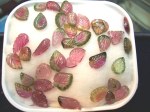








Copyright 2009-2014 Mahavir Gems. All Rights Reserved.
MAHAVIR GEMS

Tourmaline:
Tourmaline occurs with a full range of colours. Parti-coloured crystals or crystals with colour zoning is more common in tourmaline than other minerals. Colour zoning could be concentric or length-wise which reflects on the mode of crystallization. Often more than two distinct colours are seen in the same crystal. Of all the parti-colored crystals the watermelon tourmaline is quite fascinating wherein the major central portion is red and the border being green passing through a state of whiteness. When carved, the parti-colored specimens appear very attractive, such as, fruits from the red portion and leaves from the green portion.
Tourmaline crystallizes in hexagonal system. Invariably, it occurs as elongated prismatic crystals. Trigonal and hexagonal cross-section and striation parallel to c axis are characteristic of this mineral. Trigonal pyramidal termination is evident in many crystals which appear like the symbol of Mercedes Benz when viewed from the top. Cleavage is more or less absent, but in thin sections fractures subparallel to a axis are quite characteristic. Fracture is conchoidal and the lustre is vitreous.
Often rapid growth in the C direction results in the development of hollow tubes. Cavities capped by inclusion or spike on nail head inclusion may be encountered in tourmaline. Fibrous hollow tubes, needles like inclusions and fluid inclusions elongated in c direction or channel leaching cause chatoyancy, producing tourmaline cat's eye. Cat's eye effect can also be obtained when the finely striated relatively flat prism face is kept as the base of cabochon. This kind of effect is often described as quasi-chatoyancy.
Transparent pink-red, blue, green, yellow-brown and uncoloured varieties are used as gemstones. Black opaque stones are also often cut and worn as mourning jewellery (even a serious affair like mourning has also become fashionable by wearing jewellery with black stones). Although many terms have been used to describe tourmalines, technically elbaite (alkali-rich), dravite (Mg-rich) and schorl (Fe-rich) are the main subdivisions of tourmaline. Of these the attractively coloured transparent gem varieties mainly fall under the subgroup elbaite or alkali tourmaline.
Among these pink-red varieties are called rubellite, blue - indicolite (indigolite), lilac to violet bluesiberite, green-verdelite and colourless- achroite. Overall the transparent gem varieties have SG 3.03-3.10, RI, ~ 1.62, w 1.64, 5 = 0.018. Birefringence is high enough to exhibit the doubling effect when observed under a loupe. Much more conspicuous feature of tourmaline is its pleochroism or dichroism. In pale coloured stones, however, dichroism may not be evident.
The composition of chromium tourmaline is closer to dravite. It appears red through the Chelsea filter and exhibit a fluorescent doublet in the red region (675 nm) of the absorption spectrum. Fibrous varieties of tourmaline produce prominent cat's eye effect or chatoyancy. The blue, green and yellow green varieties are often erroneously referred to as Brazilian sapphire, Brazilian emerald and Brazilian peridot respectively. Dravite is yellow brown to almost black in colour. The lighter yellow brown variety is cut as gemstones. Schorl, the most common variety in nature, is black and opaque and possess higher SG.
Varities of Tourmaline
Achroite
Rubelite
Verdelite
Indicolite
Dravite
Siberite
Schrol







Worldwide Occurrences
Tourmaline is typically found in acid igneous rocks such as granite, luxullianite and pegmatite; and due to boron metasomatism in metamorphic rocks. Gem tourmaline bearing pegmatites are also associated with topaz, cassiterite, spodumene, petalite, apatite, fluorite, lepidolite and opaque minerals like columbite-tantalite. Dravites are usually associated with metamorphicmetasomatic assemblages as well as in basic igneous rocks along with axinite and datolite. Being harder and chemically resistant mineral it is also found in placer deposits and in sedimentary rocks.
Gem tourmalines are found in Minas Gerais in Brazil, Elba in Italy, Zambia-Zimbabwe-Tanzania in East Africa, Madagascar, Afghanistan, Myanmar, Sri Lanka, Russia, Maine and San Diego in USA, Canada, Mexico, Australia and Nepal.
Indian Occurrences
Fine green tourmaline have been reported from Sunjam (33° 25':76° 25') and other places in Jammu and Kashmir; green and blue varieties in Mani Mundar (24° 37:85° 52), indicolite near Pilura (24° 37': 85° 52'), blue and brown in Lapta Burn (22° 48:85° 44) and Jhanda Burn (22° 6':85° 42') in Bihar. The mica belt of Andhra Pradesh contains tourmaline. In Tamil Nadu the lower grade green tourmaline occurs in Kiranur (10° 47':78° l7'), Tiruchirapalli district and in Karnataka near Srirangapatnam, Mysore district. The recent report from Orissa (Mishra and Mohanty, 1995) reveal green, blue and particoloured tourmaline from Charbhati-Beldihi- Rairakhol and Meghpal-Ranchipada, Sambalpur district; Bargocha south of Manmundra, Phulbani district; also (unconfirmed) Barozara, Boudh district.
Schorl or black tourmaline occurs in several parts of India (Iyer, 1961). The more desired transparent varieties have restricted occurrence. Common schorl occurs in younger Badrinath granites of UP Himalaya and Sikkim Himalaya, Aravallis of Rajasthan, Eastern Ghats and Dharwars of South India.
Alexandrite type tourmaline from Scharby, Urals, appears brownish or yellow green in daylight and orange red in incandescent light (Dietrich, 1985).
Tourmaline - Important Characteristics
Classification
Hardness (Mohs Scale)
Chem. formula
Composition
Crystal System
Colour
Atomic (Crystal )Structure
Index of Refraction
Density (Relative)
Luster
Uses
:Mineral
:7
:Na(Al,Fe,Le,Mg,Mo)Al(Si6O16)(BO3)4
:Tetrahedra silica.
:Hexagonal (Trigonal)
:Various Colours.
:Granular.
:1.62-165
:2.55 - 2.58
:Vitreous to semi-transparent
:Jewelry, ornamental.
Tri Coloured Tourmaline
Rubelite

Bi Coloured Tourmaline
Carvings
This site is best viewed on 1024 x 768 screen resolution using Mozilla 3.5 Browser
